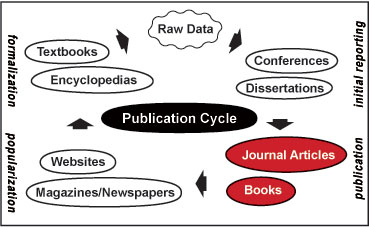Understanding the form of some major types of academic publications will help your research:
- Reference Sources
- When beginning a new area of study, it is often necessary to get an overview of a topic, explanations of unfamiliar terms, or brief factual information. Reference sources, such as encyclopedias, dictionaries, and handbooks, provide quick access to this type of factual or background information. An academic encyclopedia article may provide an especially useful starting point, since it will not only give a concise overview of your topic and provide a broader context, but it will also likely provide a bibliography of key information sources. Go beyond Wikipedia—the library has hundreds of more reliable academic encyclopedias online and in print.
- Books and Documents
- Research results are often eventually published in monographs—books which provide an in-depth overview of a topic, or in collections of essays covering different perspectives of the topic. Many academic books are published by university presses (e.g., University of Toronto Press). Academic libraries also often have many government documents, which contain the results of research carried out by or for governments.
- Articles
- The most current academic information can often be found in journals, which periodically publish new research articles in a specific subject area. Scholarly journal articles are crucial to academic research in most disciplines, as explained in Section 4 (Evaluating Your Results).

- The Scholarly Publication Cycle
- Scholarly communication generally flows through a publication cycle, which includes the major publication types mentioned earlier. Typically, information starts as a researcher’s raw data (top of diagram), moves from being communicated informally (conferences) to more formal reporting and publication (dissertations, journal articles, books), and then often becomes popularized (magazines, newspapers, websites) and generalized or formalized (encyclopedias, textbooks). You should note, however, that this is a simplified diagram. Information also flows counter-clockwise, it does not always take every form identified, and the process varies from discipline to discipline. For example, some academic writers have never written a PhD dissertation, while others have written many journal articles but will never write a book, or vice versa. Yet, understanding the general evolution of information will help you to access and evaluate it effectively. Especially note the position of articles and books in the process—the publication of academic journal articles and books typically takes place only after a considerable amount of work, and before the information becomes a part of common and accepted knowledge.
- Primary vs. Secondary Sources
- The publications that make up the publication cycle can be either primary sources of information or secondary sources. Although exactly what constitutes a primary or secondary source varies by discipline, there are some general differences between the two types of sources. A primary source is an original document written during the time under study, or raw data resulting from original research. For example, diaries, autobiographies, e-mails, newspaper articles, and journal articles that provide primary reports of research are all primary sources. Creative works, such as novels or music, may also be primary sources, as are the original writings of scholars and academic theorists whose works have subsequently been studied by others. Secondary sources, on the other hand, are documents that analyze events or primary sources. They are removed from the time of the original event, and they interpret or discuss the original event or data. Examples of secondary documents are textbooks, encyclopedias, and journal articles that interpret events, discuss data, or review the literature on a topic. In fact, many publications found in academic libraries (outside of special sections such as archives, newspaper rooms, literature collections, etc.) are secondary sources.
- Where to Start
 So, what type of publication should you start with? Follow the “reverse pyramid” method. Start with the most general information and then move on to publications that tend to be more specific. This usually means starting with a quick reference tool like an encyclopedia to get an overview of your topic, then going on to more in-depth books, and finally getting to the more specific (and likely more technical) journal articles last. The publications listed above can be found by using various search tools—databases on the UNB Libraries’ website which let you discover different types of publications. Try a Subject Guide for your research area, which will direct you to librarian-recommended tools and other information sources. From UNB Libraries' homepage, select your subject area from the list under the heading Research by Subject.
So, what type of publication should you start with? Follow the “reverse pyramid” method. Start with the most general information and then move on to publications that tend to be more specific. This usually means starting with a quick reference tool like an encyclopedia to get an overview of your topic, then going on to more in-depth books, and finally getting to the more specific (and likely more technical) journal articles last. The publications listed above can be found by using various search tools—databases on the UNB Libraries’ website which let you discover different types of publications. Try a Subject Guide for your research area, which will direct you to librarian-recommended tools and other information sources. From UNB Libraries' homepage, select your subject area from the list under the heading Research by Subject.
CHAT is closed.
CHAT is away.
CHAT is busy.
CHAT requires JavaScript.
 So, what type of publication should you start with? Follow the “reverse pyramid” method. Start with the most general information and then move on to publications that tend to be more specific. This usually means starting with a quick reference tool like an encyclopedia to get an overview of your topic, then going on to more in-depth books, and finally getting to the more specific (and likely more technical) journal articles last. The publications listed above can be found by using various search tools—databases on the UNB Libraries’ website which let you discover different types of publications. Try a Subject Guide for your research area, which will direct you to librarian-recommended tools and other information sources. From
So, what type of publication should you start with? Follow the “reverse pyramid” method. Start with the most general information and then move on to publications that tend to be more specific. This usually means starting with a quick reference tool like an encyclopedia to get an overview of your topic, then going on to more in-depth books, and finally getting to the more specific (and likely more technical) journal articles last. The publications listed above can be found by using various search tools—databases on the UNB Libraries’ website which let you discover different types of publications. Try a Subject Guide for your research area, which will direct you to librarian-recommended tools and other information sources. From